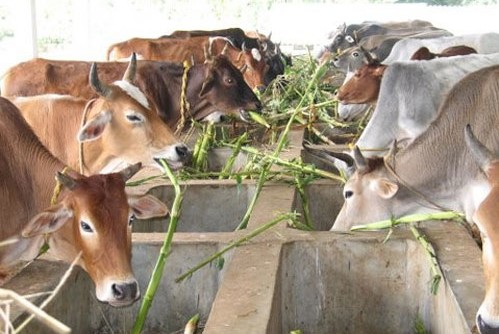
Plants at VSPCA
Our animal shelter is a special environment designed to:
- make a pleasant habitat for our animals
- provide refuge for wildlife from the surrounding fast-developing areas
- grow useful plants for our animal’s feed and for sale
- provide a beautiful place where visitors will want to come so that they can learn and contribute to animal welfare and hopefully adopt their own companion animals.
Plants at VSPCA include:
Silver Oak trees grow at least 40 feet in height and are very useful mostly for cricket bats. These trees are used for tree lodging housing in tourist spots like Aruku (nearby to Visakhapatnam). They are planted all along the boundary to the entrance inside right at the back of the Seetaphal trees.
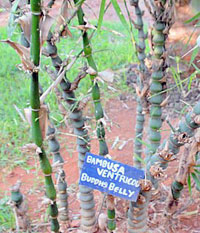
Buddha’s belly – a type of bamboo.
Seethaphal trees not only bear delicious fruit, much in demand in the marketplace, but is also a medicinal plant. They have been safely grown in areas so the cattle will not disturb them and have been planted close together so when they grow bigger in size the thickness of their stems would act as a natural boundary as well.
We have planted shade green grass wherever there is free space. This grass does not need sunlight. Shade grass grows fast, serves as eatables to star tortoises and as nutritious green fodder for the cattle.
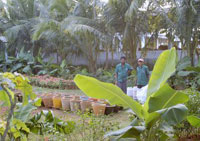
Goshala workers and green experts Appa Rao and Tata Rao. Appa was a mason but since working at VSPCA has become a skilled horticulturist and loves his work. Plants are part of the goshala work which also include biogas and vermicompost.
Now we get 3 bags of 50 kgs of this grass daily for the cattle. The plants are beautiful in appearance and above all gives you a clean green top. The dogs and cats eat them as medicine as well.
Then we have the Subhabool trees planted all along the boundary side inside. Subhabool can grow very big but we cannot take advantage if it grows like this. Since it is harvesting the leaves we are interested in for our cattle. In order to take advantage of this, we do not allow the tree to grow high and we cut the leaves every four feet in height when they are tender and nutritious. Therefore we can space thousands of trees only a few inches apart whereas a full-grown tree needs five feet spacing. This is how we get more from less land and use many innovative ideas to make the best use of our resources. So here is an additional three 50 kgs. bags of feed daily for the cattle from these trees.
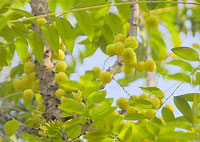
Gooseberry which we feed to the monkeys and other wildlife.
We have grown all sorts of fruits trees mainly for the shelter animals like monkeys, birds, squirrels, parakeets, crows, mynahs, bats and not only for residential animals but for all those animals visiting our shelter who cannot find food elsewhere due to the development all around us. Our land is also a haven for the squirrels.
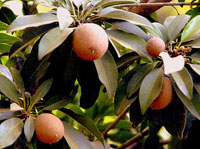
Sapota (local name – chickoo).
The fruit trees growing in our shelter are:
- amla
- amlokhi
- badam
- banana
- blackberries
- cherry
- coconut
- gooseberries
- guava
- jackfruit
- lemon
- lichy
- mango
- papaya
- pomegranate
- sapota (chickoo)
- supari nut
- water apple
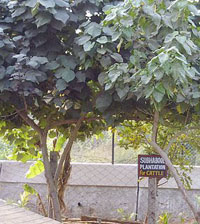
Subhabool trees.
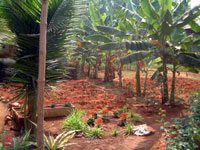
Coconut trees.
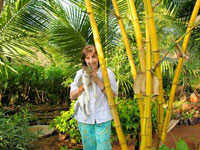
Eileen, Tarzan the cat and yellow bamboo.

Papaya.
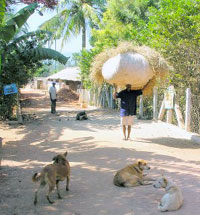
Carrying dry hay for the cows which is the residue from the harvested rice fields. Trees to his right and left are the Seethaphal trees and behind these are the Silver oaks.
Plants we grow for sale:
- bamboo grass and trees
- banyan
- Christmas trees
- cycus
- fig
- neem trees
- peepal trees
- phycus
- palm variety of four types
- silver oak
- teak
Creepers:
All 15 varieties of different flower types have been planted all along the buildings and areas that can cover, provide shade and set natural boundaries.
The aviary is covered with five varieties. When the dogs have poor digestion they relish eating the betel creepers.
Flowers are grown for aesthetics and for the benefit of butterflies and small insects (below a sampling of hundreds growing):
- Alamanda
- bougainvillaea of fifteen varieties
- gaddi gulabi
- ganneru
- hibiscus of all varieties
- jasmine of all varieties
- lantanas of seven varieties
- lilly
- marigolds
- nandivardhana
- night queen
- orchids of three types
- roses
- seasonal flowers
- upurbia
- yellow flower trees
We also grow for sale indoor and ornamental plants of 70 varieties.
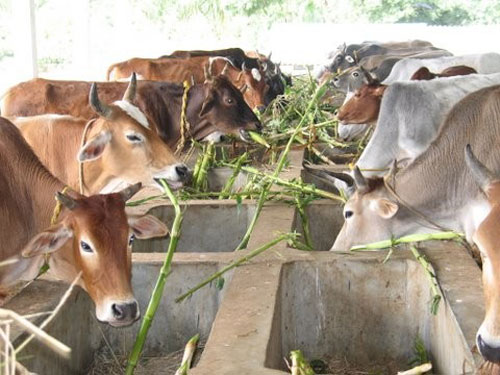
Cows enjoying green grass.
